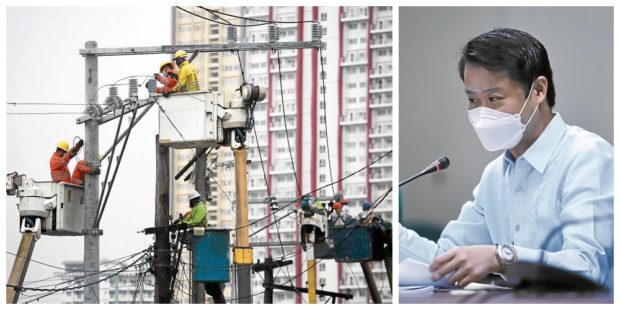Gatchalian: Owners of empty flats, rest houses got power rate cuts meant for poor

SUBSIDY PROGRAM LEAKS Sen. Sherwin Gatchalian says P937 million in subsidies went to “nonmarginalized” consumers in 2018 alone due to leaks in the lifeline power rate program intended only for the poor. The leaks have been there for 20 years, he says. —LYN RILLON/SENATE PHOTO
MANILA, Philippines — Owners of rest houses and rarely occupied apartments in residential towers were among those who got electricity rate discounts intended for the poor or the so-called lifeline consumers, according to Sen. Sherwin “Win” Gatchalian.
Gatchalian has filed a bill that would extend by 20 years the lifeline rate, or the subsidized power rates given to low-income consumers who cannot afford to pay at full cost.
But he said officials must first find ways to plug the leaks that allow what he called nonmarginalized consumers to benefit from the program.
Shouldered by middle class
Going by his own computation, Gatchalian said roughly P937 million in subsidies went to nonmarginalized consumers in 2018 alone.
The subsidized rate is given to customers whose power consumption is 100 kilowatt-hours or below a month, as prescribed by the Electric Power Industry Reform Act of 2001.
Article continues after this advertisementThe subsidy is shouldered by other customers, including power users from the middle and lower-middle classes.
Article continues after this advertisementBut since the discount is based on electricity consumption, owners of rest houses and apartments in high rises that are occupied only a few times a year also get the discount as their power use is low, Gatchalian said.
Unplugged leaks
He showed a copy of the power bill of an apartment owner who got a P16 subsidy after the owner moved to the family home during the lockdown. Comparing the poverty incidence in the country and the number of lifeline consumers who got the subsidized rates, he said around P937 million in subsidies went to nonmarginalized consumers in 2018.
“The intention is good, the senators support it, but there are [leaks] that have been detected throughout the years. I am just surprised that even after 20 years, we [have] not [plugged] these [leaks],” Gatchalian said in a hearing. It is “disheartening” that the government is not undertaking any validation process and that the amounts meant to help do not always go to the intended beneficiaries, he added.
Poverty level review
Gatchalian asked the Energy Regulatory Commission (ERC) and the Department of Energy (DOE) to conduct a comprehensive study and draw up a strategy to plug the leaks.
Alvin Ortega, chief of the ERC’s Tariff and Rates Division, said the ERC would try to link its data on lifeline users with that of the Department of Social Welfare and Development on the poor.
DOE Director Mario Marasigan proposed that there be an evaluation of the poverty level of consumers.
Authorities could check if the consumers are residents of resettlement or urban poor areas, for instance, Marasigan said.
Cash grant program
If they live in condominiums, they should not be entitled to the lifeline subsidies, he said.
Apartment buildings, or residential towers, are called condominium in the Philippines. The apartments in those buildings are locally called units.
National Electrification Administration chief Edgardo Masongsong said the lifeline subsidy should be included in the cash grant program of the government for the poor, or the 4Ps program, rather than be shouldered by “nonlifeline” consumers.
Masongsong said extending the lifeline may burden the working class customers who shoulder the subsidy.
Gov’t should shoulder subsidy
Victorio Dimagiba of Laban Konsyumer Inc. said the leaks were the results of inefficiency and mismanagement on the part of the regulators.
Dimagiba also said the government should be the one shouldering the subsidy and not consumers from the middle and lower-middle classes.
Since helping the lifeline consumers was a government policy, “[the] government should walk the talk,” he said.
Since it’s the other consumers that shoulder the subsidy, the ERC does not keep a close watch on it, Dimagiba said.
But it would surely plug the leaks if the subsidy were taken from the government, he added.